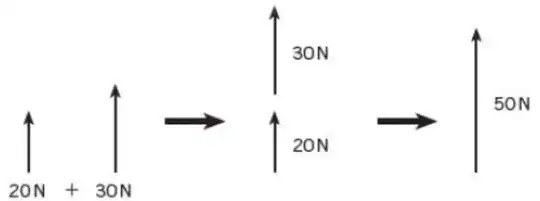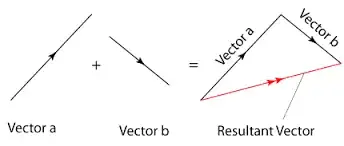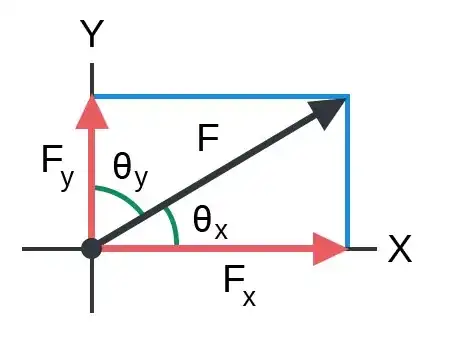There is a simple answer. Forces add this way because they are vectors, and vectors add this way. It's just how their math works.
Of course, this is a bit of a cop-out. It's not quite satisfying because it starts from the assumption that forces are vectors. If they are vectors, it is easy to show they add this way, because they do. But why can we assume forces are vectors in the first place?
If we look at the mathematics, vectors have the following properties:
- $a + (b + c) = (a + b) + c$ -- The "associative property"
- $a + b = b + a$ -- The "commutative property"
- $0 + a = a$ -- There is a "zero" vector
- $a + -a = 0$ -- Every vector has an inverse
- $1\cdot a = a$ -- There is a "scalar identity" (multiplying by 1 doesn't change the vector)
- $k(a + b) = ka + kb$ -- multiplying by a scalar "k" distributes
- $(j+k)a = ja + ka$ -- multiplying scalars by a vector commutes.
These are the properties of vector spaces. They're just a set of properties that showed up often enough in mathematics that we gave it a name and studied them a bit. That's all.
So the question for us is "do we believe" that forces have all of these properties? We can go down the list and convince ourselves that they do. For example, the first one (the associative property) can be shown that if Alice joins Bob and Charlie in pushing on an object, the forces they exert are the same as if Alice and Bob join Charlie. The difference between those two is so small that we intuitively might not even realize they're different. The fact that those situations are equivalent lets us know that forces follow this associative property.
Likewise we can find that it doesn't matter if we consider the force by Alice first, then Bob, or if we consider the force by Bob and then consider Alice, the result doesn't change. That's why it is commutative.
Its reasonably easy to think through the zero force and the idea that every force can have an inverse. In fact, we see that inverse quite often in the concept of "an equal and opposite reaction."
Multiplying by scalars is pretty easy to work through too. If Alice and Bob are applying forces, and then they apply 5x as much force, that is identical to Alice applying 5x more force and Bob applying 5x more force (again, so natural that one might not even realize those are different). And we can see that if Alice applies 2+5 pounds of force to something, that is equivalent to Alice applying 2 pounds and Bob applying 5 pounds in the same direction as Alice.
If you accept all of these things as true statements about forces, then you can conclude that forces are indeed vectors. And after concluding that, you can use all of the imagery we see in this question/answer to handle addition of vectors, such as the parallelogram image. Why do they add this way? If you sit down and hammer on the math long enough, you will realize that that is the only way two vectors could add which satisfies the above 7 properties. Any other addition will cause one of them to break down.
So that's really how forces can be added. You determine that forces have the properties of vectors, and then you know they must add in the only possible way vectors can add.
Probably the most important part of this addition approach is that addition of vectors is commutative. $a + b = b + a$. In most visualizations, you will notice that there are two paths you can take through the addition. One starts with $a$ and adds $b$ to it. The other starts with $b$ and adds $a$ to it. By the rules of vectors, those additions must commute, meaning they must give you the same value. You are free to try to find another way to add vectors, but most of the intuitive ones you may think of will not have this important property.


